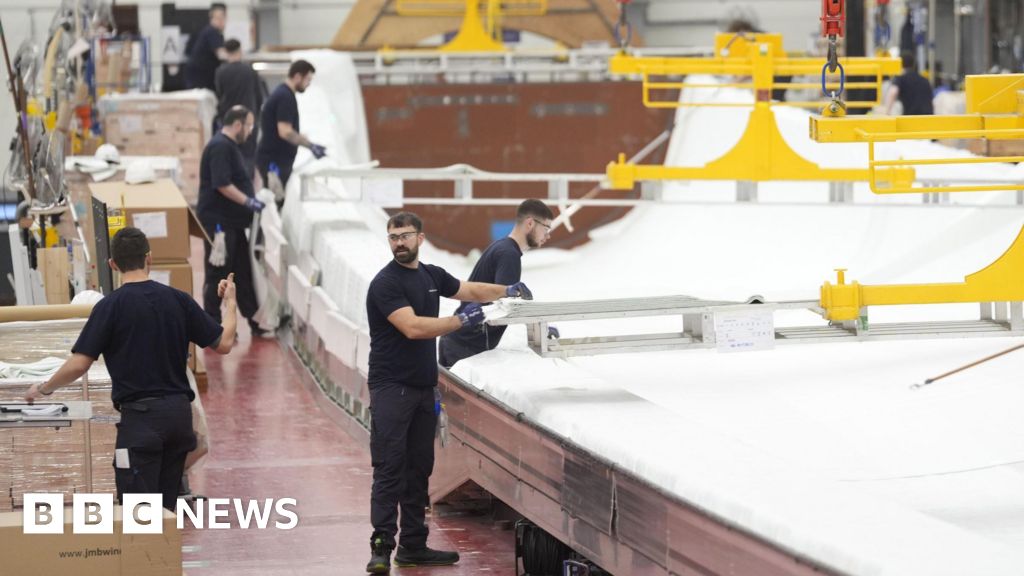Tech
Nokia readies for comms AI super cycle with R&D facility | Computer Weekly

The city of Oulu in Finland has received a further boost to its prestige in the field of mobile communications research, design and manufacturing, with Nokia’s opening of what it calls the new home of radio, in the form of a research and development hub for the entire lifecycle of 5G and 6G radio innovation that will design, test and deliver next-generation networks built for artificial intelligence (AI).
And as the ribbons were being cut by Finland president Alexander Stubb to officially open the site, Nokia president of mobile networks Tommi Uitto said the company was embarking on developing the next generation of mobile technologies to address shifting market conditions driven by a forthcoming AI super cycle.
Nokia’s presence in Oulu goes back to 1973, when its radio technology department – with 25 employees and 16 trucks of equipment – moved from Helsinki to the city in Finland’s midlands just below the Arctic Circle, to engage in a secret military radio project. Since then, Nokia operations in Oulu have played a role in each success generation of mobile communications.
Stubb said its creation was a clear statement that it pays to invest in Finland. “It also says that network infrastructure is key – when you’re working on 5G or 6G, you’re creating the neural network of whatever we do in artificial intelligence, whatever we do in robotisation or internet of things,” he said.
Arkkitehtitoimisto ALA was the architect of the site for which construction was carried out by YIT, starting in the second half of 2022, with the first employees moving into the facility in the first half of this year.
Covering the entire lifecycle of product development, the site will host around 3,000 Nokia personnel from 40 nationalities working alongside universities, startups and technology companies in the Oulu region with the stated aim of shaping tomorrow’s networks. Overall, the footprint of the building is 55,000 square metres, including manufacturing, R&D and office space, and the campus will cover the entire product lifecycle of a product, from R&D to manufacturing and testing of the products.
Nokia stresses that sustainability is integral to the facility, with renewable energy used throughout the site, and all surplus energy generated fed back into the district heating system and used to heat 20,000 local households. The onsite energy station is claimed to be one of the world’s largest CO2-based district heating and cooling plants, boasting 100% waste utilisation rate and 99% avoidance in CO2 emissions.
Verification environments
The comms firm also boasts that the campus contains some of the world’s most advanced radio network laboratory and manufacturing technology, and will provide both simulated and real-world field verification environments to accelerate network evolution, ensuring that secure 5G and 6G networks are designed, tested and built in Europe.
The campus will also take advantage of Oulu’s ecosystem as a global testbed for networks both for civilian communications applications and defence. Nokia has a long-standing relationship with the university of Oulu, and has already begun research into prospective 6G technologies after providing support for 5G development.
A current project with the local university involves 5G-connected construction vehicles as part of a plan to build an autonomous low-emission swarm on infra construction machinery involving excavators, bulldozers, compaction machines and dump trucks. Partners in the project supplying the likes of machine control technologies on control technologies, LiDAR, vehicles, sensing systems and trucks include Novatron, Satel, Desitia, Moptel, Sisu Truck, GIM Robotics and Sandvik.
Current work in the defence sector includes a partnership with local firm Bittium, with whom Nokia is building real-time situational awareness through resilient and seamless communications across the battlefield. Nokia is also part of the Defence Innovation Accelerator for the North Atlantic (Diana) Network creating services for Nato forces. Work in this field has encompassed dual-use technologies; extreme condition technologies; 5G/6G research and AI-enhanced networks; and next-generation hybrid networks allowing person-to-person connectivity between tactical and mobile networks.
There is no doubt that the onset of AI has radically transformed the communications industry over the recent past from the context of AI in networking and also networking in AI. But when the Oulu centre was in its design phase, let alone before the digging of the first shovel into the ground in 2022, AI super cycles were not envisaged even if some key applications such as video collaboration and gaming exemplified the need to bolster upstream connectivity capability on networks.
The immediate focus at the base will centre on 5G including 5GPP Standardisation, system-on chips, 5G radio hardware, and software and patents. The Oulu Factory, part of the new campus, will target production of Nokia’s 5G radio and baseband products.
In addition, Nokia said its research and innovation would cover product areas from massive MIMO radios such as Osprey and Habrok to next-generation 6G services, creating secure, high-performance, future-proof connectivity.
“Our teams in Oulu are shaping the future of 5G and 6G developing our most advanced radio networks,” said Nokia president and CEO Justin Hotard. “Oulu has a unique ecosystem that integrates Nokia’s R&D and smart manufacturing with an ecosystem of partners – including universities, startups and Nato’s Diana test centre.
“Oulu embodies our culture of innovation, and the new campus will be essential to advancing connectivity necessary to power the AI super cycle,” he said. “If you look ahead in the world that we’re in at the start of the AI cyber cycle, connectivity is only going to become more essential.
“As we think about where we are today, and the dependence we have on our mobile devices, that’s one step,” said Hotard. “But whether it’s augmented reality and virtual reality, drones, robotics, autonomous vehicles: there’s going to be many, many additional places where connectivity becomes essential to delivering, delivering the kind of innovation that will make the world smarter, safer and, ultimately, brighter. We really believe that [the new hub] is a core foundation of that innovation for Nokia.”
Expanding on his belief in the importance of ecosystems, he added that one thing he firmly believes in is that, in the world of technology, partnerships is everything. Hotard said that of all the successful technologies, such as cloud and mobile, there wasn’t just one successful firm. There were always partners, whether it was silicon and software, cloud and systems, and there was innovation through collaboration. This, he said, will be true with AI, where the early winners came through partnership and collaboration.
Demand cycle
Hotard stressed that such an ecosystem mindset was equally important for Nokia as it looked ahead with 5G and 6G in a marketplace that was going to go through another demand cycle in connectivity.
“I think we’re in a period where – you can call it digestion, you can call it balancing – the new applications haven’t formed yet,” he said. “For example, if you think about smart glasses, they create a very different profile for the network than mobile devices, because you’re uploading all of the content, and what’s coming down is much lower. That’s a transition.
“We haven’t seen that pivot yet,” said Hotard. “Those types of things will continue to evolve for us. It’s about investing in the core innovation and taking advantage of that opportunity. I believe the AI super cycle will drive investment in mobile infrastructure and mobility over time. And I think that’s going to continue for us. I think it is a massive opportunity.”
Uitto cited research backing up the emergence of these dynamics and the way in which upstream will gain importance. “The Bell Labs estimate is that mobile network traffic will grow at the pace of at least 19% – that’s the modest scenario,” he said. “There’s also a 28% CAGR scenario – five times over the next five to six years. So far, the growth in mobile traffic networks has been very much driven by video.
“However, now what we foresee is that AI will be driving further traffic growth [through] different types of AI applications,” said Uitto. “And it will also actually change, interestingly, the traffic profile so that the uplink performance from device to the network, that traffic will grow relatively speaking more than the downlink. And what this then drives is network investments. That that’s how we then indirectly benefit, also in the radio access networks from the use of AI.”
Radio technology
The upshot was that 6G would see Nokia looking at added investments in radio technology, in particular spectral efficiency improvements, and in being cloud-first and software-driven with open application programming interfaces (APIs). The latter would not be about monetising the APIs directly, but providing access to them.
Hotard was adamant that if you look at the lessons of 4G and 5G, the forthcoming 6G industry needs to provide new sources of monetisation other than just the network itself. How the ecosystem flows and takes advantage of that was, he conceded, maybe still a question, but he saw a great opportunity nonetheless.
On the subject of 6G monetisation opportunities, Uitto highlighted the architecture’s potential. For example, with a non-real-time RAN intelligent controller, there will be an interface on top of which you could write apps – some of which in turn could be used for monetisation. He also cited service management and orchestration, one of the hottest topics in mobility business, where there were opportunities for network slicing and also network-as-a-code on the core network side.
Going forward, Uitto held out the prospect of utilising cloud RAN. “If you built it in such a way that some of the computing for base station would be made with the AI-capable GPUs [graphics processing units] … then maybe some of that computing capacity could be sold to anybody who needs inferencing capacity,” he said. “You could imagine, in our wildest dreams, a base station site being a far edge cloud site capable of computing and inference.
“In 6G, there is also Isac, integrated sensing and communication, that should also open some new opportunities of monetising the network, because your radio is eventually capable of modelling the physical world as a digital twin, and then constantly monitoring the changes in the physical world,” said Uitto.
Interestingly, he saw the 6G deployment roadmap as beginning as an overlay on 5G standalone networks. Partly a matter of timing, he noted that 5G standalone was still scarcely deployed – especially in Europe – and by the time all 5G networks were standalone, that would be the signal to introduce G6 as a radio interface, partly AI-based and partly a deterministic AI air interface, coinciding with 5G standalone service management and orchestration.
Tech
After OpenAI’s new ‘buy it in ChatGPT’ trial, how soon will AI be online shopping for us?

Buying and selling online with e-commerce is old news. We’re entering the age of A-commerce, where artificial intelligence (AI) is increasingly able to shop for us.
At the end of September, OpenAI launched its “Buy it in ChatGPT” trial in the United States, using AI agents built to interact with us to do more of people’s browsing and shopping. The technology is known as “agentic commerce,” sometimes shortened to A-commerce.
American shoppers can now ask for shopping suggestions from US Etsy sellers within a ChatGPT chat—then buy a product immediately, without having to navigate away to look at individual shop pages.
Looking ahead, big companies are now spruiking the next phase of “autonomous A-commerce,” which experts predict could see AI checking out for some shoppers within the next few years.
But is handing over more of our shopping decisions to AI a good thing for us as shoppers, for most businesses or for the planet?
What’s possible right now?
For most people using AI to help them shop, the AI agent is still mostly just searching and recommending products. It still has to shift the customer to the retailer’s website to complete the checkout.
For instance, AI can do most steps to order a pizza—though sometimes slower than doing it yourself—apart from paying at the end.
That’s when we step in: we still need to sign in if we’re part of a loyalty program, enter our personal and delivery details, then finally pay.
With the “Buy it in ChatGPT” trial now underway in the US, the customer never leaves the chat, where the checkout is completed.
Shopify has said more than 1 million of its merchants will soon be able to check out within ChatGPT too. Major US retailer Walmart has similar plans.
What’s next?
In May 2025, Google launched “AI mode shopping.” Some features, like using a full body photo of yourself to virtually “try-on” clothes, are still only available for US shoppers, with limited brands.
At the time, Google said its next step will be a new “agentic checkout […] in coming months” for products sold in the US. It would give shoppers the option of tracking a product until its price drops to within a set budget—then automatically prompting them to buy it, using Google Pay. That checkout option is yet to launch.
Credit card giants Visa and Mastercard are also working on ways to make it easier for AI agents to shop for us.
Both the current and coming forms of A-commerce have the potential to spread fast worldwide, because they run largely on the same global digital infrastructure powering today’s e-commerce: identity, payments, data and compliance.
Consultants McKinsey forecast: “We’re entering an era where AI agents won’t just assist—they’ll decide.”
What are the risks and benefits?
Overspending is a big risk.
A-commerce removes many steps of the shopping journey found in e-commerce or physical commerce, leading to fewer abandoned carts and potentially higher spending.
People would need to trust AI systems with their private data and preferences, and ensure they’re not misused. Permitting AI to shop on your behalf means you are responsible for the purchase and can’t easily demand a refund.
AI systems might focus on price or speed, but not always for what you value most: from how sustainable a product is, to the ethics of how it was made.
Fraud could be a real issue. Scammers could set up AI storefronts to trick the AI, collect the money and never deliver.
Banks will need to figure out how to spot fraud, process refunds, and manage consent when it’s not a person pressing “buy,” but an algorithm doing it on their behalf.
Regulators will need to consider A-commerce in their competition, privacy, data, and consumer protection rules.
A-commerce could offer some limited environmental benefits compared to today’s way of shopping, such as fewer missed deliveries—if you’re happy to share your calendar so your AI agent knows your availability.
But greater consumption would also mean greater environmental impacts: from AI’s voracious energy and water use, to the damage done by fast fashion, more deliveries and indirect pollution.
Changing how we shop and do business
If you have even a small business, the way you make your products and services discoverable online will have to change.
Instead of just having websites built for customers and search engines, all businesses will need to build AI accessible online stores. Those will not look like the websites we see today. It will be more like a data-soaked digital catalog, filled with everything an AI agent needs to place orders: product specifications, price, stock, ratings, reviews, through to delivery options.
All those years of bigger brands buying attention and dominating search results might start to matter less, if you’re able to build a good AI accessible online store. It could be a quiet but massive shift in how trade works.
However, each business’s visibility will depend on how AI systems read and rank sellers. If a business’s data isn’t formatted for AI, it may disappear from view. That could give larger players an edge and once again make it harder for smaller businesses to compete.
How much are we happy to delegate our shopping to AI agents? Our individual and collective choices over the next few years will shape how radically shopping is about to change for years to come.
This article is republished from The Conversation under a Creative Commons license. Read the original article.![]()
Citation:
After OpenAI’s new ‘buy it in ChatGPT’ trial, how soon will AI be online shopping for us? (2025, October 25)
retrieved 25 October 2025
from https://techxplore.com/news/2025-10-openai-buy-chatgpt-trial-ai.html
This document is subject to copyright. Apart from any fair dealing for the purpose of private study or research, no
part may be reproduced without the written permission. The content is provided for information purposes only.
Tech
Why electricity costs so much in the UK (it’s not all about the weather)

The UK government is reportedly considering abandoning its goal of removing fossil fuels from the country’s electricity supply by 2030 in an attempt to keep energy bills down.
This is understandable given that the UK is already one of the most expensive places in Europe to use electricity, something that—despite plenty of investment in relatively cheap renewable energy—is unlikely to change any time soon. In fact, bills remain high even when wind farms are spinning at full capacity.
However, neither a drive to decarbonize the grid—which is needed for other reasons—nor abandoning this target is going to make energy significantly cheaper. The reason for this lies in how electricity markets work, and in the geography and policies that shape the UK’s energy system.
To begin with, wholesale electricity prices are determined in a way that essentially means that everyone has to pay for the most expensive source of electricity used at a given time, which in the UK is mostly gas power plants.
The gas which is burned to power the UK’s lights and kettles has to be liquefied, shipped from the US or Qatar amid global bidding wars, and then converted back into its original state. High gas prices drive high wholesale prices, which directly translate into high electricity bills.
Cheaper renewable energy sources (the cost of producing solar, wind or nuclear electricity is very low) have little effect. This is partly because while the operating cost of renewable electricity is very low, the cost of setting it up is not.
To encourage companies to build new generation capacity, the government must offer them a guaranteed price for the electricity they produce, to compensate for their costs. For a wind farm, this would include money for planning applications, as well as buying and installing turbines and electrical equipment.
Bringing different sources of electricity to consumers also requires expensive infrastructure investment. In the UK, for example, grid capacity is not where it needs to be after decades of low investment.
Nearly 40% of the electricity produced by Scottish wind farms has been wasted so far this year, because the grid was not able to move it to other parts of the UK or store it.
Overall then, consumers’ bills will be high, both now and in the future, because of the combined costs of imported gas, infrastructure and the guaranteed prices for producers.
Most calls to decrease these bills effectively come down to suggesting moving some of these costs on to taxpayers—so effectively from one bill to another. This is what happened in France, where “cheap” nuclear electricity is the result of vast amounts of government spending in the past. The French may not see UK-level energy bills, but they do have higher taxes and public debt.
Clouds on the horizon
Despite these challenges, successive UK governments have committed to continuing investment in new technologies, because dependence on imported, polluting and volatile fossil fuels is deemed too risky. Postponing the full transition to renewables, as reported in the Guardian, is effectively a bet that gas prices will decrease in the short term, and that the UK will be able to commission cheaper renewables later on.
But cheaper renewables present their own problems, because they play different roles. Solar and wind are cheaper, but intermittent. Nuclear is the most expensive but works all the time.
This all presents a challenging situation for UK consumers. New nuclear faces very long safety and planning procedures and the national grid needs to be modernized. The decision to cancel an ambitious project to get solar electricity from Morocco may be regretted.
But the main factor is simply geography and timing. Partly due to its location, the UK has become a world leader in wind power, a renewable technology that seems to be taking a less important global role than solar. And while the cost of solar production is decreasing steeply, the learning curve is slower for wind.
And there is no obvious way to increase the number of sunny hours in England. A country like Spain, with both a lot of sun and wind, has a much easier job transitioning to cheap renewables than the UK.
So, for all the frustration over high bills, the UK’s options are limited. Geography gives us wind, not sunshine. Policy has delivered world-class renewables, but also a grid struggling to carry their power.
The future will depend on whether new technologies, including cheaper batteries, tidal power and small modular nuclear reactors can fill the gaps left by weather and planning delays.
None of this will be easy or cheap. But the alternative—continued dependence on imported, volatile fossil fuels that make bills hostage to global crises—is worse.
UK consumers face a future where electricity remains more expensive than much of Europe, not only because of policy choices, but because it lacks the sunshine that’s driving costs down elsewhere. Betting on emerging technologies is the only way to close that gap.
This article is republished from The Conversation under a Creative Commons license. Read the original article.![]()
Citation:
Why electricity costs so much in the UK (it’s not all about the weather) (2025, October 25)
retrieved 25 October 2025
from https://techxplore.com/news/2025-10-electricity-uk-weather.html
This document is subject to copyright. Apart from any fair dealing for the purpose of private study or research, no
part may be reproduced without the written permission. The content is provided for information purposes only.
Tech
Dealing With Hearing Loss? These Over-the-Counter Hearing Aids Could Help

If you’re spending hundreds or thousands of dollars buying an OTC hearing aid, make sure you’re getting a product that offers a sustainable long-term solution to your hearing loss needs. Aside from the obvious things like sound quality, take a few minutes to look into these specs.
What size and style works best for you? Most hearing aids on the market are classified as either behind-the-ear (BTE) or in-the-ear (ITE). BTE hearing aids are probably what you think of when you picture a hearing aid, consisting of a plastic case that contains the electronics, a thin cable that goes over the ear and inside the canal, and a tiny speaker known as a “receiver,” which sends boosted audio from a person’s surroundings into their ear. By contrast, ITE models are self-contained units that look like a standard pair of wireless earbuds. In-the-ear hearing aids are popular for their incognito aesthetic, and they tend to be a lot easier to pop in and out than their behind-the-ear counterparts. Still, contemporary BTE hearing aids are significantly smaller than the ones “back in the day.” It just comes down to what fits you most comfortably.
Replaceable or rechargeable batteries? Much like wireless earbuds, most OTC hearing aids are equipped with rechargeable batteries and (usually) a portable charging case for easy transport. If you take the case’s battery life into account, you’ll find most OTC models last about a week before you need to connect to a power source. Without the case, rechargeable hearing aids offer anywhere from 10 to 24 hours of battery life per charge (but this goes down by a few hours if you’re using them to stream via Bluetooth). Replaceable batteries, such as those found on the Sony CRE-C10, can last for 70 hours or more before the battery dies. Sounds great, but it means having spares on hand and wrestling with tiny cells, which can be difficult for people with dexterity problems.
Are you comfortable making adjustments? While prescription hearing aids are fitted in-office by a licensed hearing care specialist, OTC devices are self-fitting. In most cases, OTC hearing aid users are expected to be able to tune the devices to their ears, usually with the help of a smartphone app. It’s certainly nice to make your own adjustments on the fly, but it may cost you in the way of personalized care.
What’s the company’s customer support like? If only you could count on quality support from every hearing aid manufacturer! Unfortunately, OTC hearing aid companies are just that—companies. There’s no “standard” for customer service in the industry. Companies like Jabra offer patients comprehensive support, but other brands may leave you on your own.
Is there a trial run? If you’re not happy with your hearing aids, you’ll probably want to have the option to return them without writing all that money off as a sunk cost. Most states require manufacturers to provide patients with a minimum trial period, but I recommend playing it safe by seeking out this info before buying.
What about warranties? Equally important to a reasonable trial period is the inclusion of a comprehensive manufacturer’s warranty. Most brands cover manufacturing defects for up to a year, but it goes without saying that the longer the coverage period, the better the deal. No matter which OTC hearing aid you end up with, make sure the warranty covers loss, damage, and wear and tear.
-

 Tech7 days ago
Tech7 days agoHow to Protect Yourself Against Getting Locked Out of Your Cloud Accounts
-

 Tech7 days ago
Tech7 days agoThe DeltaForce 65 Brings Das Keyboard Into the Modern Keyboard Era—for Better or Worse
-

 Business7 days ago
Business7 days agoGovernment vows to create 400,000 jobs in clean energy sector
-

 Sports1 week ago
Sports1 week agoPCB confirms Tri-nation T20 series to go ahead despite Afghanistan’s withdrawal – SUCH TV
-

 Tech1 week ago
Tech1 week agoThe Best Part of Audien’s Atom X Hearing Aids Is the Helpful, High-Tech Case
-

 Tech1 week ago
Tech1 week agoI Tested Over 40 Heat Protectant Sprays to Find the Best of the Best
-

 Business7 days ago
Business7 days agoDiwali 2025: Gold & silver likely to consolidate next week; Here’s what analysts said – The Times of India
-

 Tech1 week ago
Tech1 week agoSome major Australian towns still have poor phone reception—it’s threatening public safety






